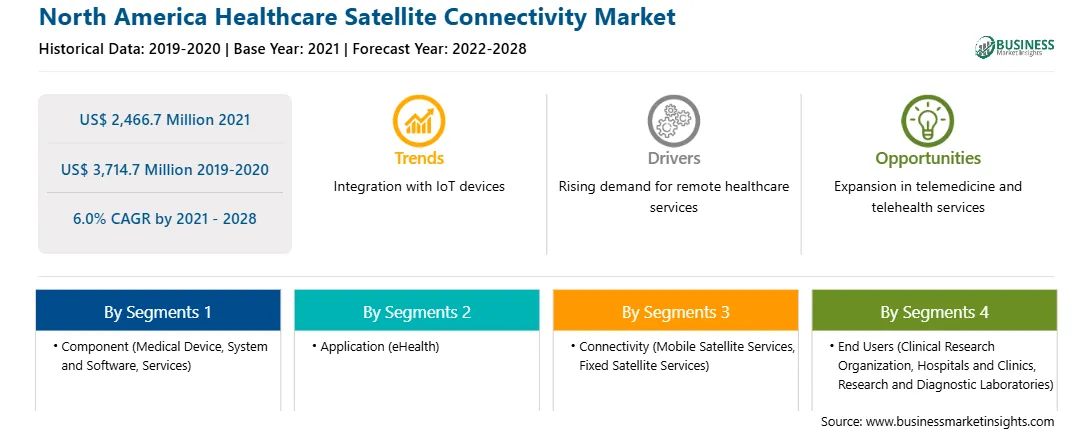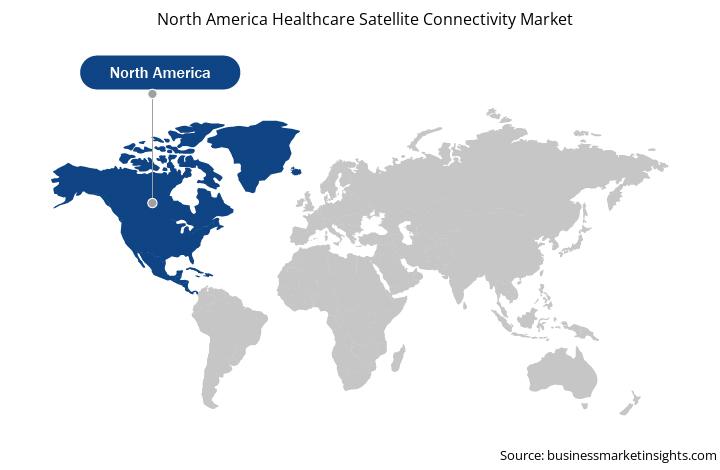North America Healthcare Satellite Connectivity Market
No. of Pages: 167 | Report Code: TIPRE00024814 | Category: Technology, Media and Telecommunications
No. of Pages: 167 | Report Code: TIPRE00024814 | Category: Technology, Media and Telecommunications
Healthcare Satellite Connectivity simply means "healing at a distance," and refers to the use of information and communication technology to enhance patient outcomes by increasing access to treatment and medical data. Additionally, healthit.gov defines telehealth as “the utilization of electronic information and telecommunications technologies to support and promote long-distance clinical healthcare, patient and professional health education, public health and health administration.
Thus, the rising adoption of eHealth is expected to create a significant demand for healthcare satellite connectivity in the coming years, which is further anticipated to drive the healthcare satellite connectivity market.
The COVID-19 pandemic has resulted in a significant increase in the reliance on telemedicine and telehealth for the provision of health care services. COVID-19 has caused a massive acceleration in the use of telehealth. Consumer adoption has skyrocketed, from 11 percent of US consumers using telehealth in 2019 to 46 percent of consumers now using telehealth to replace canceled healthcare visits. For instance, according to a report published by the US National Library of Medicine, National Institutes of Health in November 2020, "as Coronavirus continues to spread, many hospitals and physician practices have transitioned to telemedicine to conduct nonessential appointments. A study of NYU Langone Health trends (New York, NY, USA) showed a decline of 80% in in-person visits and a 683% increase in telemedicine visits between March 2 and April 14, 2020. As the number of COVID-19–infected patients increase, using computers and tablets for telemedicine can also reduce staff exposure in ambulances and hospitals. It is expected that demand for these services will increase dramatically in the US over the next few months, with shares of one telehealth provider, Teladoc Health Inc., increasing almost 50% since the start of 2020. Hospitals and health systems are already encouraging people with suspected COVID-19 symptoms to use telehealth services to limit people's flow to already crowded emergency rooms and doctor surgeries. Therefore, the growing demand for telemedicine during COVID-19 in North America is likely to boost the growth of the healthcare satellite connectivity market.

Strategic insights for the North America Healthcare Satellite Connectivity provides data-driven analysis of the industry landscape, including current trends, key players, and regional nuances. These insights offer actionable recommendations, enabling readers to differentiate themselves from competitors by identifying untapped segments or developing unique value propositions. Leveraging data analytics, these insights help industry players anticipate the market shifts, whether investors, manufacturers, or other stakeholders. A future-oriented perspective is essential, helping stakeholders anticipate market shifts and position themselves for long-term success in this dynamic region. Ultimately, effective strategic insights empower readers to make informed decisions that drive profitability and achieve their business objectives within the market.

| Report Attribute | Details |
|---|---|
| Market size in 2021 | US$ 2,466.7 Million |
| Market Size by 2028 | US$ 3,714.7 Million |
| CAGR (2021 - 2028) | 6.0% |
| Historical Data | 2019-2020 |
| Forecast period | 2022-2028 |
| Segments Covered |
By Component
|
| Regions and Countries Covered | North America
|
| Market leaders and key company profiles |
|
The geographic scope of the North America Healthcare Satellite Connectivity refers to the specific areas in which a business operates and competes. Understanding local distinctions, such as diverse consumer preferences (e.g., demand for specific plug types or battery backup durations), varying economic conditions, and regulatory environments, is crucial for tailoring strategies to specific markets. Businesses can expand their reach by identifying underserved areas or adapting their offerings to meet local demands. A clear market focus allows for more effective resource allocation, targeted marketing campaigns, and better positioning against local competitors, ultimately driving growth in those targeted areas.

The Healthcare satellite connectivity market in North America is expected to grow from US$ 2,466.7 million in 2021 to US$ 3,714.7 million by 2028; it is estimated to grow at a CAGR of 6.0% from 2021 to 2028. With 5G-enabled wearable devices, healthcare providers can monitor patients remotely and gather real-time data for preventative care and other individually tailored healthcare provisions. A report from Accenture reveals that 65% of consumers and 86% of doctors agree that wearables increase patients’ engagement with their health. This engagement is expected to decrease hospital costs by 16% over the next five years. Patients with chronic conditions can also retain autonomy and improve outcomes with reliable, always-on mobile personal emergency response systems. AT&T notes that even though remote technology brings many benefits, usage is “limited by the capacity of the network to handle the data.” A slow network with unreliable connections could result in doctors being unable to meet patients and obtain critical healthcare data about them, especially in an emergency. 5G technology reduces the chances of such incidents and allows healthcare providers to deliver treatment seamlessly to chronically ill patients with the fastest network available.
In terms of component, the system and software segment accounted for the largest share of the North America healthcare satellite connectivity market in 2020. In terms of application, the eHealth segment accounted for the largest share of the North America healthcare satellite connectivity market in 2020. In terms of connectivity, the fixed satellite services segment accounted for the largest share of the North America healthcare satellite connectivity market in 2020. In terms of end user, the hospitals and clinics segment held a larger market share of the healthcare satellite connectivity market in 2020.
A few major primary and secondary sources referred to for preparing this report on the healthcare satellite connectivity market in North America are company websites, annual reports, financial reports, national government documents, and statistical database, among others. Major companies listed in the report are Inmarsat Global Limited, Hughes Network Systems, SES S.A., X2nSat, Expedition Communications, Globalstar, EUTELSAT COMMUNICATIONS SA, AT&T Intellectual Property, DISH Network L.L.C., and Ligado Networks.
By Component
By Application
By Connectivity
By End User
By Country
The North America Healthcare Satellite Connectivity Market is valued at US$ 2,466.7 Million in 2021, it is projected to reach US$ 3,714.7 Million by 2028.
As per our report North America Healthcare Satellite Connectivity Market, the market size is valued at US$ 2,466.7 Million in 2021, projecting it to reach US$ 3,714.7 Million by 2028. This translates to a CAGR of approximately 6.0% during the forecast period.
The North America Healthcare Satellite Connectivity Market report typically cover these key segments-
The historic period, base year, and forecast period can vary slightly depending on the specific market research report. However, for the North America Healthcare Satellite Connectivity Market report:
The North America Healthcare Satellite Connectivity Market is populated by several key players, each contributing to its growth and innovation. Some of the major players include:
The North America Healthcare Satellite Connectivity Market report is valuable for diverse stakeholders, including:
Essentially, anyone involved in or considering involvement in the North America Healthcare Satellite Connectivity Market value chain can benefit from the information contained in a comprehensive market report.